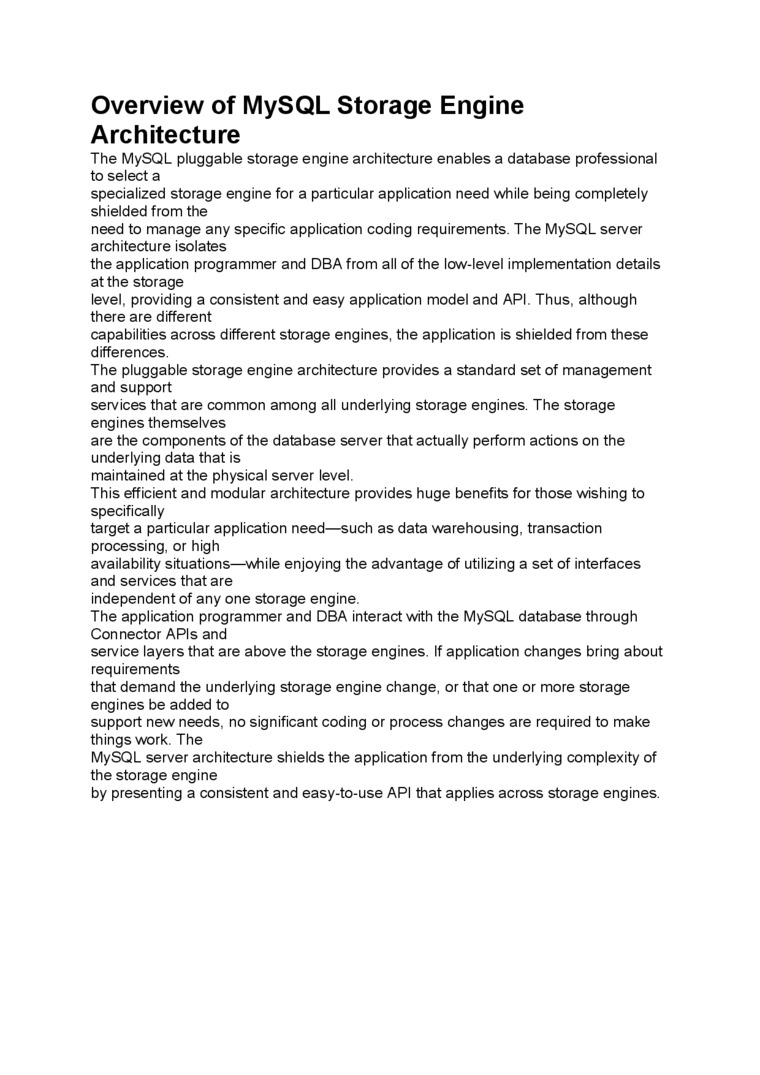89428

Overview of MySQL Storage Engine Architecture
The MySQL pluggable storage engine architecture enables a database professional to select a
specialized storage engine for a particular application need while being completely shielded from the
need to manage any specific application coding requirements. The MySQL server architecture isolates
the application programmer and DBA from all of the low-level implementation details at the storage
level, providing a consistent and easy application model and API. Thus, although there are different
capabilities across different storage engines, the application is shielded from these differences.
The pluggable storage engine architecture provides a standard set of management and support
services that are common among all underlying storage engines. The storage engines themselves
are the components of the database server that actually perform actions on the
underlying data that is
maintained at the physical server level.
This efficient and modular architecture provides huge benefits for those wishing to specifically
target a particular application need—such as data warehousing, transaction Processing, or high
availability situations—while enjoying the advantage of utilizing a set of interfaces
and services that are
independent of any one storage engine.
The application programmer and DBA interact with the MySQL database through Connector APls and
sen/ice layers that are above the storage engines. If application changes bring about requirements
that demand the underlying storage engine change, or that one or morę storage engines be added to
support new needs, no significant coding or process changes are required to make things work. The
MySQL server architecture shields the application from the underlying complexity of the storage engine
by presenting a consistent and easy-to-use API that applies across storage engines.
Wyszukiwarka
Podobne podstrony:
Overview of MySQL with Windows Failover Clustering Microsoft Windows is consistently ranked as the t
Overview of Hydrogen Storage R&D: FundingBudget for Fuel Celi and H2 Billion JPYBillion JPYq 732
Overview of Hydrogen Storage RD&D: Targets & Timeline Timeline for Hydrogen Storage
About Tables The table is the basie unit of data storage in an Oracle database. It holds all user-ac
Deviations from SQL Standards MySQL s implementation of foreign keys differs from the SQL standard i
History of MySQL We started out with the intention of using the mSQLdatabase system to connect to ou
MySQL Enterprise Oracle offers technical support in the form of MySQL Enterprise. For organizations
Overview of InnoDB Row Storage The storage for rows and associated columns affects performance for q
Replication • As of MySQL 5.6, the relay-log. info file contains a linę count and
The Main Features of MySQL This section describes some of the important characteristics of the MySQL
Workarounds for Reliability with Non-Transactional Tables But how do you use the features of MySQL S
Initial Startup of MySQL Cluster on Windows Once the MySQL Cluster executables and needed configurat
MySQL Cluster HardwareSoftwareand Networking Requirements One of the strengths of MySQL Cluster is t
MySQL Cluster Overview MySQL Cluster is a technology that enables clustering of in-memory databases
Quick Test Setup of MySQL Cluster To familiarize you with the basics, we will describe the simplest
usage in New Zealand. A less detailed overview of the NZ table of radio spectrum allocations is give
18 Economics and Eiwironment 4(51) • 2014Evaluation and Condusions The presented synthetic overview
International Journal of Computer Science & Engineenng Survey (UCSES) Vol.6, No.2, April 2015 Th
International Journal of Computer Science & Engineenng Survey (UCSES) Vol.6, No.2, April 2015 Th
więcej podobnych podstron